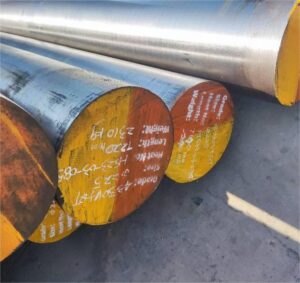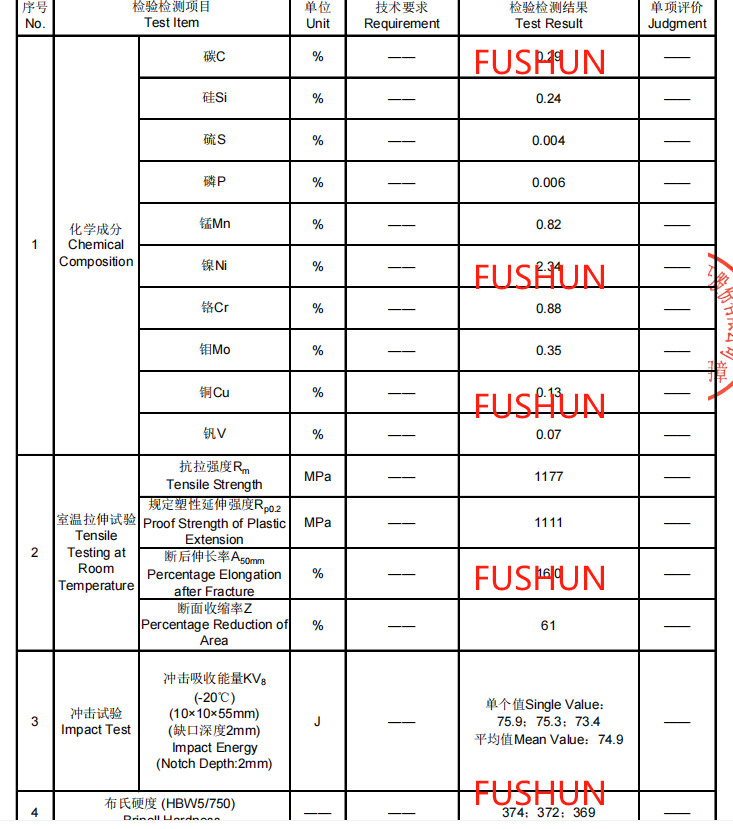Your Content Goes Here
4330V Alloy Steel: Uses, Composition, Properties

Introduce
What is 4330V alloy steel?
AISI 4330V is a Nickel Chrome Molybdenum (NiCrMo) hardened and tempered high strength alloy steel for applications in the oil and gas industry. It is typically used for oil tools and drilling jars due to its combination of high strength and exceptional impact properties.
AZoM definition 1
What is 4330V MOD?
4330V and the steel grade with adjusted composition is referred to as 4330V mod. 4330V mod alloy steel is been modified with vanadium to improve its strength and hardenability.
Different 4330V Grade
According to the yield strength, 4330V can be classified into 135KSI, 150KSI, 155KSI, all of which are the minimum yield strengths required after being hardened and tempered.
4330V can be manufactured via Electric Arc Furnace, followed by Ladle Refining and Vacuum Degassing and is either cast into bottom-poured wide end up ingots, or Continually Cast. If it is used in aviation and aerospace equipment, it is required to use vacuum melting.
What is 4330V MOD VAR?
4330 MOD VAR AMS 6411 is AISI 4330 Steel modified with the addition of Vanadium, It is a low alloy steel capable of being heat treated to high strength levels. Vanadium is added to improve impact strength and hardenability, This is a premium aircraft quality steel usually produced as a consumable electrode remelted product (VAR). AMS 6411 also allows the 2ndmelt to be ESR (Electro-Slag Remelting) when specified by the end-user.
Application
Where is 4330V alloy steel uses?
1. Oil and Gas Industry:
The oil and gas industry is one of the primary users of 4330V steel due to its demanding operational environments.
Operational Demands: Drilling deeper wells and operating in harsher environments necessitate materials that can withstand greater stresses.
Safety and Cost Efficiency: Using 4330V steel reduces the risk of equipment failure, enhancing safety and minimizing costly downtime.
- Drilling Equipment:Components such as drill string members, drill collars, heavy-weight drill pipes, tool joints, and subs.
- Wellhead Equipment:Parts like blowout preventers, valves, and other pressure control equipment.
- Completion Tools:Packers, hangers, and other downhole tools that require high strength and toughness.
2. Aerospace Industry:
Weight Reduction: The high strength-to-weight ratio of 4330V allows engineers to design lighter components without compromising strength.
Performance: Components can endure the stresses of takeoff, landing, and turbulent conditions, ensuring passenger safety and aircraft integrity.
- Landing Gear Components:Struts, fittings, and other heavily loaded parts that require exceptional strength and fatigue resistance.
- Engine Components:Shafts, gears, and other parts subjected to high stress and rotational speeds.
3. Construction and Heavy Machinery:
- Crane Components:Pins, shafts, and booms that need to support heavy loads.
- Mining Equipment:Drill bits, cutters, and other wear-resistant parts.
4. Military and Defense Applications:
- Armored Vehicles:Structural components requiring high impact resistance.
- Weapon Systems:Gun barrels, firing mechanisms, and other critical parts.
5. Power Generation:
- Turbine Components:Parts in steam and gas turbines that operate under high stress and temperature conditions.
Why this industry choose 4330V steel?
1. Exceptional Strength and Toughness:
- High Tensile and Yield Strength:The alloy can be heat-treated to achieve very high strength levels, essential for components that must withstand significant loads.
- Excellent Toughness:The addition of vanadium enhances grain refinement, resulting in improved toughness and the ability to absorb energy without fracturing.
2. Good Fatigue Resistance:
- Fatigue Life:4330V steel has superior fatigue properties, making it ideal for components subjected to cyclic loading, such as drilling equipment and aircraft landing gear.
- Reliability:Components made from 4330V can operate reliably over extended periods, reducing downtime and maintenance costs.
3. Enhanced Hardenability:
- Uniform Mechanical Properties:The steel can be through-hardened in large sections, ensuring consistent properties throughout the component.
- Versatility in Heat Treatment:It responds well to various heat treatment processes, allowing customization of mechanical properties to suit specific applications.
4. Resistance to Impact and Shock Loads:
- Impact Toughness:High Charpy V-notch values indicate excellent resistance to impact loads, which is crucial for drilling equipment encountering hard formations or landing gear absorbing landing shocks.
- Durability:The steel’s ability to withstand sudden loads without failure extends the service life of components.
5. Vanadium Addition Benefits:
- Grain Refinement:Vanadium promotes fine grain size during heat treatment, enhancing strength and toughness.
- Precipitation Strengthening:Vanadium carbides form during tempering, contributing to higher strength.
6. Good Machinability and Fabrication Characteristics:
- Machining:Despite its high strength, 4330V can be machined effectively with appropriate tooling and processes.
- Weldability:It can be welded with proper precautions, such as preheating and post-weld heat treatment, to prevent cracking and retain mechanical properties.
7. Resistance to Hydrogen Embrittlement:
- Sour Service Suitability:In the oil and gas industry, equipment often encounters hydrogen sulfide (H₂S), which can cause hydrogen embrittlement. 4330V steel can be processed to resist this phenomenon, making it suitable for sour service environments.
Chemical Composition
What is 4330V alloy steel chemical composition?
| Grade | C | Mn | Si | P | S | Cr | Mo | Ni | V |
| 4330V | 0,30-0,34 | 0,75-1,00 | 0,15-0,35 | < 0,025 | < 0,010 | 0,75-1,00 | 0,40- 0,50 | 1,65-2,00 | 0,05- 0,10 |
How these elements affect 4330V steel?
Carbon (C):
- Increases strength and hardness
- Enhances hardenability
- Content around 0.3% balances strength and toughness
Manganese (Mn):
- Acts as deoxidizer
- Improves hardenability
- Increases strength
Silicon (Si):
- Acts as deoxidizer
- Increases yield strength
- Improves oxidation resistance
Phosphorus (P) and Sulfur (S):
- Harmful elements, must be strictly controlled
- Reduce toughness and ductility
- Can cause brittleness
Chromium (Cr):
- Enhances hardenability
- Improves wear and corrosion resistance
- Forms carbides to increase strength
Molybdenum (Mo):
- Refines grain structure
- Improves tempering stability
- Enhances high-temperature strength
Nickel (Ni):
- Increases toughness
- Improves hardenability
- Enhances low-temperature properties
Vanadium (V):
- Refines grain structure
- Forms carbides to increase strength
- Improves tempering resistance
What is 4330V alloy steel produce standard?
ASTM A26, ASTM A646, API 7 Specification
What is 4330V MOD VAR standard?
AMS 6411, AMS 6427, CE-0906 (Bendix), BMS 7-122 (Boeing)
BMS 7-27(Boeing), FMS 1012 (General Dynamics), EMS 96242 (Honeywell)
Mechanical Properties
What is 4330V alloy steel mechanical properties?
| 4330V | 135ksi 1-10”(Mid Radial) 10-12.5”(1″below) |
150ksi 1-10″(Mid Radial) 10-12.5”(1”Below) |
155ksi 1-10”(Mid Radial) 10-12.5”(1”Below) |
| 0.2%Proof stress (ksi) min. | 135 | 150 | 155 |
| UTS (ksi) min. | 145 | 160 | 165 |
| %Elongation min. | 14 | 14 | 14 |
| %reduction of area min. | 50 | 45 | 45 |
| Hardness HRC | 30-36 | 34-40 | 34-40 |
| Hardness HBW | 286-341 | 319-371 | 319-371 |
| CVN@23°C(J) | 65 | 54 | 54 |
| CVN@-20″℃(J) | 32 | 27 | |
| CVN @-40°℃ | 50 |
What is 4330V MOD VAR mechanical properties?
Longitudinal Tensile Properties:
| 4330V MOD VAR Property | Value |
| Tensile Strength | 220 ksi |
| Yield Strength 0.2%offset 185 ksi | 185 ksi |
| Elongation | 10% |
| Reduction of Area | 35% |
Minimum Transverse Tensile Properties per AMS 6411:
| 4330V MOD VAR Cross-section Area | Tensile Strength |
Yield Strength 0.2% Offset | Avg.Reduction of Area | Individual Reduction of Area |
| Up to 144 in²,incl | 220 ksi | 185 ksi | 35% | 30%min |
| Over 144 in² to 225 in², incl | 220 ksi | 185 ksi | 30% | 25%min |
| Over 225 in² | 220 ksi | 185 ksi | 25% | 20%min |
Test Standard
Each bar length will be 100 % ultrasonically tested per ASTM A388, with acceptance criteria in accordance with API 6A PSL 3&4.
Note: Above a rolled size 10.25″ the central 20 % of the bar will be exduded from ultrasonic testing.
Micro Structure
Grain size will be ASTM 5 or finer.
Reduction ratio
Reduction ratio will meet 4:1 as a minimum.
Physical Properties
Density:0.283 lb/in3 (7.84 g/cm3)
Specific Heat: 0.16 Btu/lb./°F (0.16 cal/g/°C)
Workability
Forging:
- Forge between 1950 and 2250°F (1066-1232°C)
- Due to high hardening capability, preheating and furnace cooling or cooling in ash/lime is recommended
Machining:
- Normalize and temper at 1250°F (677°C) maximum prior to rough machining
- Can be machined at maximum strength, but must be followed by stress relieving at approximately 400°F (204°C)
Weldability:
- The steel has good welding characteristics
- Can be welded by resistance flash welding
Heat treatment
Furnaces surveyed and calibrated per AMS 2750.
Austenitised and liquid quenched.
Tempered to meet selected strength variant.
Supplied either stress free or stress relieved.
Note at larger sizes a normalising process may be required.
Normalize
1600-1700°F(871-927°C), air cool.
Austenitize
1550-1600°F(843-871°C),15 minutes per inch of thickness, oil quench,
Temper
500-1100°F (260-593°C), depending on desired strength. Temper between 500-700°F (260-371°C)to obtain tensile strengths of 220-240 ksi (1517-1655 MPa)
Actual Data
What is 4330V alloy steel actual data?
4330V 155KSI by Fushun:

4330V VS 4330V MOD :
4330V VS 4330V MOD chemical composition:
| Grade | C | Mn | Si | P | S | Cr | Mo | Ni | V |
| 4330V | 0,30-0,34 | 0,75-1,00 | 0,15-0,35 | < 0,025 | < 0,010 | 0,75-1,00 | 0,40- 0,50 | 1,65-2,00 | 0,05- 0,10 |
| 4330V MOD | 0,28-0,34 | 0,60-1,00 | 0,10-0,40 | < 0,015 | < 0,010 | 0,60-1,10 | 0,35- 0,65 | 1,65-3,10 | 0,05- 0,15 |
